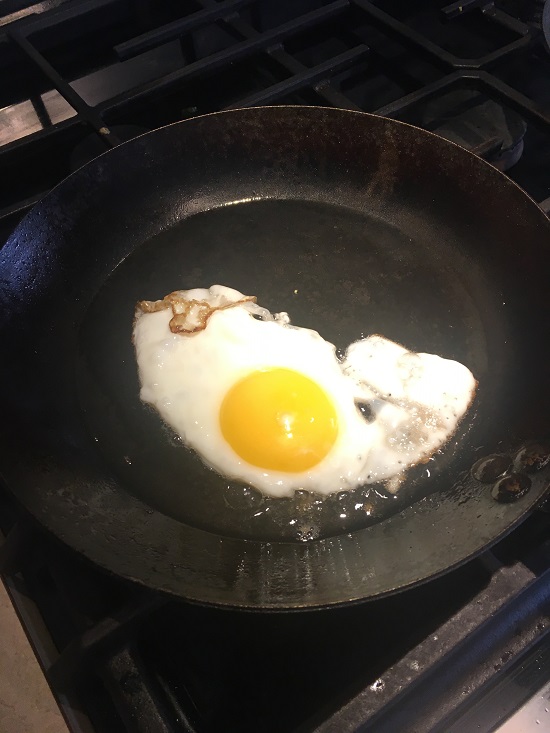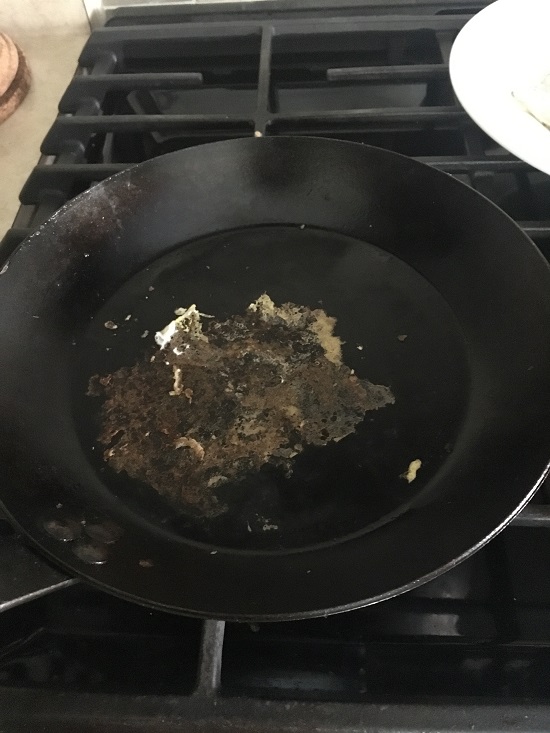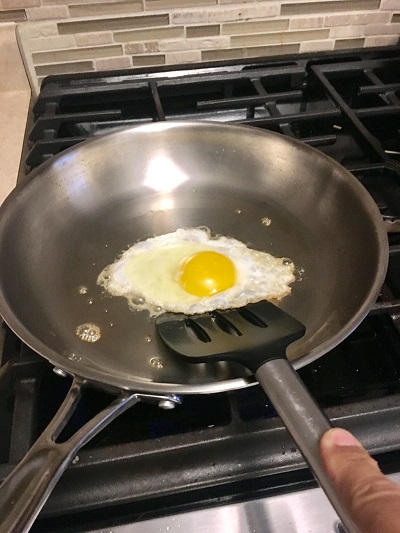This is my overview of 3 non-stick pan alternatives…..
Aka 3 experiments to find the best nonstick pan without Teflon.
And the surprising conclusion at the end.

It was that time again…. That recurring moment that happens every 2-3 years no matter how delicately you handle a non-stick pan….
Yet another non-stick pan was starting to stick!
And as I stood there, trying to scrape off the remains of scrambled eggs from the now sticky pan, I decided: Enough is Enough!
This ‘replace-a-pan-every-couple-of-years-madness’ has to stop.
I needed to switch to a pan that will last. I need to find some viable non-stick pan alternatives.
Now don’t get me wrong… I’m not taking a pro or against Teflon cookware stand here…. Personally, while my cookware of choice is stainless steel, I also ALWAYS have a non-stick pan or 2 in use in my kitchen. Because, really, how else do you cook things like eggs, crepes and pancakes without ending up with a hot mess.
…But here’s the inevitable truth, and:
THE PROBLEM WITH TRADITIONAL NON-STICK PANS
Any traditional non-stick coated pan will eventually start to stick.
No matter if you handle it like a new-born baby. No matter if the manufacturer claims it’s made out of NASA approved materials.
A day will come when….
IT. WILL. START. TO. STICK.
WHY DO NON-STICK PANS START TO STICK?
Teflon or PTFE, which most traditional non-stick coatings are made of, is a plastic. Over time and with usage, this plastic simply disintegrates. According to Wikipedia, PTFE (aka Teflon) begins to deteriorate once the cookware reaches about 260 °C (500 °F), and decomposes above 350 °C (662 °F). Meaning it literally flies away in fumes.
DESPITE LOW TO MEDIUM HEAT
Now you might be thinking, “I cook on low to medium heat, surely my trusty teflon pan doesn’t hit those super high temperatures?” You’d be surprised. The Good Housekeeping Institute did a test to see how long it would take for a non-stick pan to overheat. Surprise, surprise, an empty pan took less than 2 minutes to heat up to over 500°F. A pan with oil? A whopping 2.5 minutes to hit 514°F.
DESPITE ‘REINFORCED’ NON-STICK
So now you’re thinking ‘Yes, but my pan is reinforced with titanium/diamonds/granite/stone, surely it won’t deteriorate so easily?”. Sorry to be the bearer of bad news but no matter the reinforcements, nothing can change the fundamental properties of PTFE.
AND THE SCRATCHES ONLY MAKE IT WORSE…
Add to the plastic coating ‘flying away’ when over-heated, it also inevitably gets scratched regardless if you use wooden or silicone utensils. Over time, these scratches build up and only add to the loss in non-stick functionality.
AVERAGE LIFE OF A TRADITIONAL NON-STICK PAN
Unlike a stainless steel or cast iron pan that literally lasts for decades, most non-stick coated pans have a much shorter life:
- Around 1 year for light weight, cheap pans (or if you REALLY abuse a decent quality pan).
- Around 3 years for a good quality pan with a heavy gauge base and 2-3 layers of reinforced non-stick.
Your personal experience could be anywhere between these 2 options depending on the frequency and ‘severity’ of usage. And if your non-stick pan lasts significantly longer than 3 years without getting ‘sticky’, well then, you, have earned my utmost respect… that is a milestone I have yet to achieve.
WHAT GOT ME THINKING
So anyway, back to me standing and scraping off eggs from my pan and thinking of non-stick pan alternatives…
And also thinking of all the comments from my readers looking for non-stick pan alternatives because of safety or environmental concerns when it comes to PTFE.
And I thought, why not?
Why not experiment with cooking these ‘sticky foods’ in alternate pans and see if I can come up with a solution both to my desire to not have to replace pans every couple of years as well as a non-PTFE option for my readers.
Specifically I wanted to see if I can successfully make eggs, which happen to be a daily staple in our household, on a non-teflon pan.
A few disclaimers:
- I’m a ‘cook because I have to’ kind of person, which means convenience is super important for me
- I ALWAYS cook eggs with a light brush of oil or butter, no matter how non-stick a pan so I kept that as a constant in my experiments.
Yes I know, non-stick pans are supposed to reduce your need for adding any fat…. But in this case, a little fat goes a long way. It makes the food/eggs taste better, helps the non-stick pan function better and, if it’s a healthy fat (butter, olive oil, coconut oil), is good for you.
So now that we’ve got the fat phobia out of the way, here we have it:
3 EXPERIMENTS IN THE SEARCH FOR NON-STICK PAN ALTERNATIVES
Non-stick pan alternatives – Experiment # 1 – Carbon Steel Skillet
Type of Pan: Carbon Steel. Specifically, this is type one I own and use. Carbon steel, like cast iron is one of those materials that is naturally non-stick and is supposed to become more and more non-stick over time as the patina builds up.
For this first test, I took out my trusty Lodge carbon steel skillet. The pan I have came pre-seasoned but over time I have had to re-season it. If you’re wondering how to properly season a steel or cast iron pan, read here for a few helpful tips.
Carbon steel- first attempt:
On the first attempt, I have to admit, I added a bit more oil than I wanted to but I was really concerned about the eggs sticking.

Result: The egg came off easily enough (yay!) though there was some residue left in the pan. That scraped off easily enough so it wasn’t a complete failure.

Carbon steel – second attempt:
Not satisfied though, I went for a second attempt, this time with only a light coating of oil, much like I cook on any non-stick in order to compare apples to apples. The eggs lifted off easily enough but left a much bigger residue.

Now there’s a few reasons for that
- Maybe my pan was not seasoned properly
- Possibly I didn’t preheat it sufficiently
Conclusion – carbon steel iron as a non-stick alternative:
I’m seeing potential in this pan.
But is this really the best nonstick pan without Teflon?
And am I ready to switch to carbon steel as the non-stick pan of choice for my daily egg cooking?
No. And not yet. I think no matter how well seasoned and how much practice you put into it, a carbon steel, or for that matter a cast iron pan, will NEVER come close to the slippery ‘non-stickiness’ of Teflon.
But I think with enough use, practice (and, I have to admit, a bigger commitment to switching pans), carbon steel could very well be a viable choice for your non-stick pan needs – including cooking eggs.
2 things come into play here – commitment and effort. You’d have to choose your level to decide on this one.
Non-stick pan alternatives – Experiment #2 – Ceramic non-stick pan
Type of pan: Ceramic coated non-stick pan
This is the pan I used. I’ve been using this Caraway pan regularly for about 10 months and first reviewed it when it was brand new. As a new pan, as expected, eggs literally slid out of it. This, however, was the real test…. 10 months after being regularly used, was the non-stick going to hold up?
As before, I brushed some oil on the pan and let it heat up. Added the eggs and let them cook on medium heat.
No description could do justice to this so I’ll let this video say it all – the eggs still slide around the pan after cooking.
Now traditionally, the issue with ceramic coated non-stick pans has been that the non-stick stops performing around the 1 year mark. And I think one of the reasons for that is that people assume non-stick means zero fat usage. I truly think that for the optimal performance of any non-stick pan, you need to give it a bit of help with a light coating of fat. So with that I expect this pan to keep performing for a fair bit longer.
Conclusion – ceramic coated pan as a non-stick alternative:
For now, it seems like a good quality ceramic coated non-stick pan is a potential non-stick alternative. (Important consideration, read full review here to see why I think this particular brand is designed to be better than the average ceramic coated pan)
Is it the best non-stick pan without Teflon and would it need replacing after 2-3 years like a traditional non-stick pan? I don’t know but time will tell. Till then, I will continue to use it – always with a light brush of butter :)
Non-stick pan alternatives – Experiment #3 – Stainless Steel
Type of pan: Stainless steel
And now for the third and last attempt to try out a non-stick pan alternative. This is the pan I used, a triply pan with heavy gauge aluminum (and a fantastic price point, if you’re in the market for stainless steel cookware).
In the spirit of transparency, this is not my first attempt in life to cook eggs on stainless steel. Once, inspired by this video, I tried to replicate this experience but sadly, failed abysmally.
So here I was again, willing to try again and armed with the secrets to cooking with stainless steel. The secret, I learnt, is to heat the pan well before adding a generous helping of butter/oil. I did that, though I felt I was adding more oil than I want to consume. And right there is problem #1 with using Stainless steel as a non-stick alternative – you end up using more oil than you might want to.

When the eggs looked done, things looked promising as the eggs seem to be lifting off easily from the edges.

However, when done, there was a fair bit of residue left in the pan :(

Now of course, if I attempted a few more times, I would likely do better and maybe even master the art of cooking eggs on a stainless steel pan. But let’s be honest, that’s a bit more effort than I’m willing to spend.
Conclusion: Stainless steel as a non-stick pan alternative
Unless you’re really committed to mastering the art of cooking eggs on a stainless steel pan, I would not consider this a good alternative. Takes too much oil/fat/butter and too much of a learning curve. I’ll pass.
IN SUMMARY
So I tested a carbon steel skillet, a ceramic coated pan and a stainless steel pan to see if I could find the best nonstick pan without Teflon.
- Carbon steel – has potential but needs effort and commitment.
- Ceramic coated non-stick pan – a good quality ceramic coated non-stick pan could be a viable alternative. Question remains, however, about how long it will last and if it will outlast the expected 2-3 year lifespan of a traditional non-stick coated pan.
- Stainless Steel pan – Thanks, but I’ll pass. While I love stainless steel for other cooking, it doesn’t pass the egg test for me. Now excuse me while I go scrub the stuck-on egg residue.
SURPRISING CONCLUSION
I caved and ended up purchasing a new PTFE pan for the sole purpose of frying eggs and making crepes. This is the one I bought.
Your choice, of course, could be different.
I’m a ‘cook because I have to’ person which means I lack the interest and commitment required to master the art of cooking eggs on an alternate pan. I also don’t have a problem with using the occasional PTFE pan – convenience is important to me – along with well cooked eggs :)
Have you tried to switch your egg cooking to an alternate non-stick pan? Share your experience below.
Disclosure: I get commissions for purchases made through links in this post.
Other articles you might like: